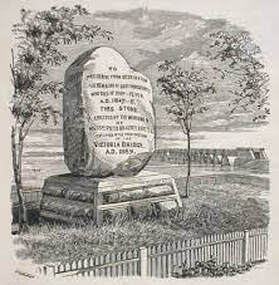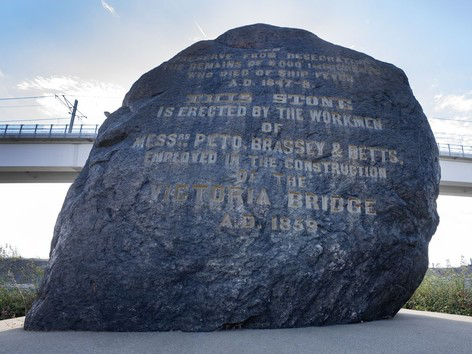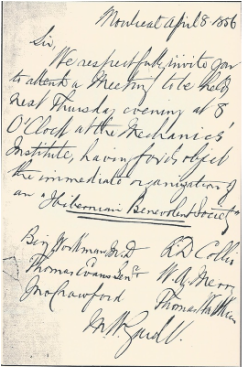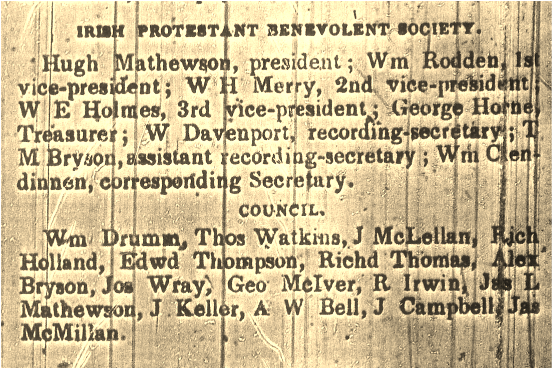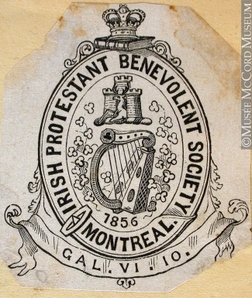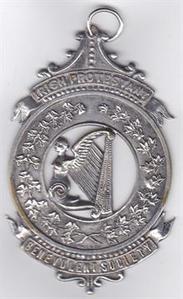History of the Irish Protestant Benevolent Society
Montreal in the 19th Century
In 19th century Montreal, socially, religiously, economically, culturally and politically, early immigrants in a minority situation in Quebec depended on themselves to survive and needed all the support they could get, and this meant that the various societies and benefit societies and political organizations that sprung up to support the new comers were critical in giving voice to their concerns and needs. The fear of death was faced almost daily as support and medical services were limited. Families were all important but, so often, poor and without means to adequately deal with health programs and old age. Education was limited to only the richer few. Churches were extremely important to all inhabitants, catholic and protestant alike.
The Irish Protestant Benevolent Society (IPBS) came into being in 1856 following the reorganization of St. Patrick's Society which, up to then, had been run on non-sectarian lines from its founding in 1834. The status of St. Patrick's Society in Montreal become exclusively Catholic in 1856. As a result the Protestant members decided to form a society of their own. The parting of the ways between the two groups was effected in friendly sprit and understanding. Whatever the circumstances, the good relations that have existed for a long time continue to this day.
In 1865 a charter incorporating the Society was granted by the Legislative Council and Assembly of Canada. It is interesting to note that this event pre-dates Canadian Confederation. The names of the original incorporators are worthy of record, many of whom have contributed in no small measure to the social and commercial progress of Montreal in particular and Canada at large.
Objects of the IPBS Society
"The objects of the Society shall be charitable by nature; to advance the welfare of Irish Protestant in Canada; to afford advice, information and assistance; to afford pecuniary aid to Irish Protestants in Canada in need; or to assist in the education of such of their children as may require and merit such assistance, and to engage in such other charitable pursuits for the benefit of Irish Protestants in Canada, as may be deemed advisable."
In the early days of the Society it was one of the President's duties to personally canvass the members and other Protestants of the community for donations to enable it to carry out its welfare work. This method was discontinued, and today the Society's chief source of income is from investments from the proceeds of gifts and bequest left by former members. At no time in its 150 years has the Society made any appeal to public or government sources for funds. During the famine which was rampant in Ireland in 1880 a sum of money was forwarded to Dublin Castle for the relief of the unfortunate sufferers, and in 1886 the Society joined the other charitable organizations in rendering assistance to the victims of the flood in Pointe St. Charles.
On the 9th of December 1905 a home was purchased on Belmont Park from part of a bequest of Mr. William Warren who had been Honorary President of the Society at the time of his death early in the same year. This home was used by the Society as its headquarters until 1930 when the property was taken over by the Canadian National Railways for the new Central Station. The present location is on Sherbrooke Sreet in Westmount.
In recent years, the Society established the Mathew Hamilton Gault Fellowship to assist students in the Irish Studies program at Concordia University under the auspices of the Canadian Irish Studies Foundation. This fellowship was funded by the membership, honorary president Leslie H. Gault, a number of foundations and The Sun Life assurance Company of Canada.
The Society continues its benevolent mandate by providing monthly monetary supplements to a number of senior citizens in need, bursaries to deserving students, and grants to a number of Montreal charities including for example, The Old Brewery Mission. As well, it has been committed to the preservation of Grosse Ile, Quebec, a National Historic Site and its significance to Irish Protestants and the Canadian experience.
Despite the formation of welfare agencies, old age pensions, family allowances, etcetera, the need remains and the demands on the Society continue. It is with a spirit of renewal, pride and faith that we enter the second half of our second century, perhaps stubbornly determined to carry on the work of The Irish Protestant Benevolent Society in rendering aid and assistance to its less fortunate countrymen, the elderly and those in need. All in the traditional way, with little publicity and display as possible.
In 19th century Montreal, socially, religiously, economically, culturally and politically, early immigrants in a minority situation in Quebec depended on themselves to survive and needed all the support they could get, and this meant that the various societies and benefit societies and political organizations that sprung up to support the new comers were critical in giving voice to their concerns and needs. The fear of death was faced almost daily as support and medical services were limited. Families were all important but, so often, poor and without means to adequately deal with health programs and old age. Education was limited to only the richer few. Churches were extremely important to all inhabitants, catholic and protestant alike.
The Irish Protestant Benevolent Society (IPBS) came into being in 1856 following the reorganization of St. Patrick's Society which, up to then, had been run on non-sectarian lines from its founding in 1834. The status of St. Patrick's Society in Montreal become exclusively Catholic in 1856. As a result the Protestant members decided to form a society of their own. The parting of the ways between the two groups was effected in friendly sprit and understanding. Whatever the circumstances, the good relations that have existed for a long time continue to this day.
In 1865 a charter incorporating the Society was granted by the Legislative Council and Assembly of Canada. It is interesting to note that this event pre-dates Canadian Confederation. The names of the original incorporators are worthy of record, many of whom have contributed in no small measure to the social and commercial progress of Montreal in particular and Canada at large.
Objects of the IPBS Society
"The objects of the Society shall be charitable by nature; to advance the welfare of Irish Protestant in Canada; to afford advice, information and assistance; to afford pecuniary aid to Irish Protestants in Canada in need; or to assist in the education of such of their children as may require and merit such assistance, and to engage in such other charitable pursuits for the benefit of Irish Protestants in Canada, as may be deemed advisable."
In the early days of the Society it was one of the President's duties to personally canvass the members and other Protestants of the community for donations to enable it to carry out its welfare work. This method was discontinued, and today the Society's chief source of income is from investments from the proceeds of gifts and bequest left by former members. At no time in its 150 years has the Society made any appeal to public or government sources for funds. During the famine which was rampant in Ireland in 1880 a sum of money was forwarded to Dublin Castle for the relief of the unfortunate sufferers, and in 1886 the Society joined the other charitable organizations in rendering assistance to the victims of the flood in Pointe St. Charles.
On the 9th of December 1905 a home was purchased on Belmont Park from part of a bequest of Mr. William Warren who had been Honorary President of the Society at the time of his death early in the same year. This home was used by the Society as its headquarters until 1930 when the property was taken over by the Canadian National Railways for the new Central Station. The present location is on Sherbrooke Sreet in Westmount.
In recent years, the Society established the Mathew Hamilton Gault Fellowship to assist students in the Irish Studies program at Concordia University under the auspices of the Canadian Irish Studies Foundation. This fellowship was funded by the membership, honorary president Leslie H. Gault, a number of foundations and The Sun Life assurance Company of Canada.
The Society continues its benevolent mandate by providing monthly monetary supplements to a number of senior citizens in need, bursaries to deserving students, and grants to a number of Montreal charities including for example, The Old Brewery Mission. As well, it has been committed to the preservation of Grosse Ile, Quebec, a National Historic Site and its significance to Irish Protestants and the Canadian experience.
Despite the formation of welfare agencies, old age pensions, family allowances, etcetera, the need remains and the demands on the Society continue. It is with a spirit of renewal, pride and faith that we enter the second half of our second century, perhaps stubbornly determined to carry on the work of The Irish Protestant Benevolent Society in rendering aid and assistance to its less fortunate countrymen, the elderly and those in need. All in the traditional way, with little publicity and display as possible.
The Irish Protestant Benevolent Society (IPBS) Legacy Projects
Over the last twelve years, the IPBS Council has engaged the membership to establish certain capital legacy projects to underline the Irish Protestant legacy and contributions to building the great city of Montreal, the Province of Quebec and Canada. A number of these projects are noted summarily below:
The Mathew Hamilton Gault Scholarship, The Canadian Irish Studies Foundation, Concordia University, to celebrate and promote the development of Irish Studies in Montreal.
The IPBS 150th Anniversary Scholarship, The Canadian Irish Studies Foundation, Concordia University, to support a worthy student studying Irish studies at Concordia Univeristy.
Irish Protestant Benevolent Society Scholarship, School of Canadian Irish Studies to support students studying Irish heritage.
Restoration of the Protestant Chapel at Grosse Isle - capital contribution.
The McCord Museum Irish Exhibit - capital contribution.
The IPBS Annual Lectures at the School of Canadian Irish Studies, Concordia University.
The Irish Protestant Society Annual Book Prize, McGill University.
The Hospital Projects - a contribution to the New Shriners Hospital for Children (adjacent to The Montreal Children's Hospital of the McGill University Heath Centre).
Montreal's Irish Stone (or Black Rock) Project - The IPBS made a capital contribution in 2021 to the 3.65 acres restoration project now underway.
The Great Irish Famine (An Gorta Mor)
The Great Famine, also known as the Great Hunger, the Famine or the Irish Potato Famine, was a period of mass starvation and disease in Ireland from 1845 to 1852 and It changed the landscape of the Irish community forever.
Montreal, refugees and the Irish famine of 1847
In September 1845, Irish farmers noticed the leaves on their potato plants starting to wilt and turn black. When the potatoes were dug up, they initially appeared to be fine, but then rotted within days. A fungus called Phytophthora infestans, accidentally brought from North America, was rapidly spreading. The cool, moist climate of Ireland allowed the spores to thrive. Virtually overnight, entire fields were infected. The Irish potato famine, also known as the Great Hunger, had begun. The 1851 Irish census recorded more than a million deaths between 1845-1849.
While many Canadians might have heard that approximately 2 million Irish starved to death (or died from typhus) in their own country in 1847 due to failure of the potato crop, very few know about the tens of thousands of famine victims who emigrated to Canada only to be buried anonymously in mass graves on Canadian shores. Desperate to escape the crisis, a flood of emigrants, loaded in Canadian timber ships, left for North America. Passage was cheap because the ships were not intended for human cargo, and conditions were horrific. They became known as “coffin ships” because so many died during the voyage. One in five died en route of disease and starvation. The total number of '47 victims for all of Canada is estimated more than 30,000.
Quarantine Stations
As immigration to North America stepped up in the early 1800, many quarantine points were set up at the ports of entry following an earlier outbreak of Cholera among new arrivals. The island of Grosse Isle, near Quebec City in the St. Lawrence River, was established as one such quarantine point in 1832 - but not put to a severe test until 1847 as thousand of starving Irish arrived for a better life in a new world.
However, when you pack so many half-starving people into a small ship for weeks on end you're asking for trouble. In 1847, Typhus fever appeared among these passengers and quickly spread as they landed at Grosse Isle. It is estimated that there are over 5, 424 Irish immigrants buried on the island from these outbreaks - and many thousand more died in the fever sheds of Montreal as their sickness developed.
Almost 500,000 Irish immigrants passed through Grosse Isle between 1832 and 1932. Today, it is run by the Canadian Parks authority and contains the Irish Memorial National Historic Site.
Montreal was in a sense the epicentre of the 1847 famine migration. It was the only major city to have famine refugees in massive numbers come into the city itself. Of the 100,000 who sailed for British North America in 1847, an estimated 70,000 arrived in Montreal, then a town of 50,000. The immigrants had been transferred from quarantine in Grosse Isle and were housed in unheated "fever sheds" near the waterfront known as Windmill Point, and those who died of Typhus were buried next to the sheds, in long trenches where coffins were piled three deep. The humanitarian effort to aid these people was remarkable. Nuns, priests, Protestant clergy and others disregarded their own safety to care for the newcomers. The Mohawks of Kahnawake brought food for the starving strangers.
The Black Rock Memorial
Workers constructing the Victoria Bridge actress the St. Lawrence River created the The Black Rock Memorial, in Pointe-St-Charles, which was erected on 1 December 1859. It is probably one of the country's most eloquent monuments and is the oldest famine memorial in America and largest in the world, outside of Ireland. It stands sentinel over the remains of an estimated 6,000 near Victoria Bridge in Montreal.
Quarantine Stations
As immigration to North America stepped up in the early 1800, many quarantine points were set up at the ports of entry following an earlier outbreak of Cholera among new arrivals. The island of Grosse Isle, near Quebec City in the St. Lawrence River, was established as one such quarantine point in 1832 - but not put to a severe test until 1847 as thousand of starving Irish arrived for a better life in a new world.
However, when you pack so many half-starving people into a small ship for weeks on end you're asking for trouble. In 1847, Typhus fever appeared among these passengers and quickly spread as they landed at Grosse Isle. It is estimated that there are over 5, 424 Irish immigrants buried on the island from these outbreaks - and many thousand more died in the fever sheds of Montreal as their sickness developed.
Almost 500,000 Irish immigrants passed through Grosse Isle between 1832 and 1932. Today, it is run by the Canadian Parks authority and contains the Irish Memorial National Historic Site.
Montreal was in a sense the epicentre of the 1847 famine migration. It was the only major city to have famine refugees in massive numbers come into the city itself. Of the 100,000 who sailed for British North America in 1847, an estimated 70,000 arrived in Montreal, then a town of 50,000. The immigrants had been transferred from quarantine in Grosse Isle and were housed in unheated "fever sheds" near the waterfront known as Windmill Point, and those who died of Typhus were buried next to the sheds, in long trenches where coffins were piled three deep. The humanitarian effort to aid these people was remarkable. Nuns, priests, Protestant clergy and others disregarded their own safety to care for the newcomers. The Mohawks of Kahnawake brought food for the starving strangers.
The Black Rock Memorial
Workers constructing the Victoria Bridge actress the St. Lawrence River created the The Black Rock Memorial, in Pointe-St-Charles, which was erected on 1 December 1859. It is probably one of the country's most eloquent monuments and is the oldest famine memorial in America and largest in the world, outside of Ireland. It stands sentinel over the remains of an estimated 6,000 near Victoria Bridge in Montreal.
The Irish Commemorative Stone, known as The Black Rock - Article in Ottawa Citizen, Oct 21, 2023
The Irish Commemorative Stone, known as The Black Rock is seen Friday, October 20, 2023 in Montreal. The monument commemorates the deaths from typhoid of 6,000 mostly Irish immigrants to Canada in 1847-48.THE CANADIAN PRESS/Ryan Remiorz Photo by Ryan Remiorz /The Canadian PressMontreal is one step closer to getting a commemorative park for the 6,000 Irish immigrants buried in unmarked graves in an industrial pocket of the city southeast of the downtown core.
This week, the Montreal Irish Memorial Park Foundation became the new owner of the solitary monument known as the Black Rock, a three-metre-tall boulder that marks the location of the largest mass grave in Canada.
The site, previously the property of the Anglican Diocese of Montreal, consists of a small patch of greenery in the median of a busy street near the base of the Victoria Bridge, which links Montreal to the south shore of the St. Lawrence River.
The foundation says the land donation by the diocese was key to its goal to transform the area — passed by around 23,000 drivers every day — into a park honouring the thousands of Irish people who died of typhus in 1847 while fleeing Ireland’s Great Famine.
Though the story is a significant chapter in the history of the city, it’s unfamiliar to many Montrealers today.
The Black Rock monument itself was an initiative of Victoria Bridge construction workers, many of them Irish themselves, who removed the boulder from the St. Lawrence River in 1859 and placed it on land after discovering the remains of Irish typhus victims.
Pollution from nearby railroad and vehicle traffic eventually coloured the monument deep black, lending it its name.
The Great Famine claimed around a million victims in Ireland, according to historical estimates. Another million fled the country, including around 100,000 who headed for Canada, then a colony of British North America.
Typhus, a highly contagious disease known at the time as “ship fever,” killed thousands at sea. Some were buried around St. Andrew’s, N.B. Canadian officials intercepted thousands more travellers at Quebec’s Grosse Ile, then known as “Quarantine Island” and now a national historic site with over 5,000 graves.
But men, women and children “deemed in good health” were allowed to continue their journey to Montreal, bringing typhus with them. Around 70,000 Irish immigrants arrived on Montreal Island, whose previous population was only 50,000.
Montreal’s mayor at the time, John Mills, commissioned the construction of more than 20 large “fever shacks” in the Pointe-Saint-Charles neighbourhood, where he and a religious order known as the Grey Nuns led efforts to care for the ill newcomers.
“The actions of Montrealers and Quebecers during the months of May to November 1847 represent the largest humanitarian action in Canadian history,” said Scott Phelan, Montreal Irish Memorial Park Foundation treasurer.
Many of them, including Mayor Mills himself, lost their lives. Some are among the dead buried in the mass grave.
“Imagine: these refugees are poor, they’re fleeing a famine, they speak only Irish (Gaelic), not French or English, and then all the citizens of Montreal donated their food, clothing, jobs,” Phelan continued.
“And let’s not forget that those 6,000 dead left over 1,000 orphans who were adopted by Quebecers, Montrealers and everywhere in the region. The humanitarian action of Montrealers and Quebecers that summer was extraordinary.”
The existence of the mass grave has never been in question, but archaeological digs in conjunction with the construction of a new light-rail train line through the area recently uncovered additional evidence: the remains of 14 people, 10 of them intact. Among them were five adults, two teenagers and three children, the youngest under a year old. The other four people, whose remains were not intact, were two adults and two babies.
With the city’s support, the Montreal Irish Memorial Park Foundation will be able to begin work on its project once electricity company Hydro-Quebec completes a new facility nearby. Construction of the park, including the reconfiguration of the street surrounding Black Rock, is expected to begin in either 2027 or 2028 and wrap up after two years.
This report by The Canadian Press was first published Oct. 21, 2023.
This week, the Montreal Irish Memorial Park Foundation became the new owner of the solitary monument known as the Black Rock, a three-metre-tall boulder that marks the location of the largest mass grave in Canada.
The site, previously the property of the Anglican Diocese of Montreal, consists of a small patch of greenery in the median of a busy street near the base of the Victoria Bridge, which links Montreal to the south shore of the St. Lawrence River.
The foundation says the land donation by the diocese was key to its goal to transform the area — passed by around 23,000 drivers every day — into a park honouring the thousands of Irish people who died of typhus in 1847 while fleeing Ireland’s Great Famine.
Though the story is a significant chapter in the history of the city, it’s unfamiliar to many Montrealers today.
The Black Rock monument itself was an initiative of Victoria Bridge construction workers, many of them Irish themselves, who removed the boulder from the St. Lawrence River in 1859 and placed it on land after discovering the remains of Irish typhus victims.
Pollution from nearby railroad and vehicle traffic eventually coloured the monument deep black, lending it its name.
The Great Famine claimed around a million victims in Ireland, according to historical estimates. Another million fled the country, including around 100,000 who headed for Canada, then a colony of British North America.
Typhus, a highly contagious disease known at the time as “ship fever,” killed thousands at sea. Some were buried around St. Andrew’s, N.B. Canadian officials intercepted thousands more travellers at Quebec’s Grosse Ile, then known as “Quarantine Island” and now a national historic site with over 5,000 graves.
But men, women and children “deemed in good health” were allowed to continue their journey to Montreal, bringing typhus with them. Around 70,000 Irish immigrants arrived on Montreal Island, whose previous population was only 50,000.
Montreal’s mayor at the time, John Mills, commissioned the construction of more than 20 large “fever shacks” in the Pointe-Saint-Charles neighbourhood, where he and a religious order known as the Grey Nuns led efforts to care for the ill newcomers.
“The actions of Montrealers and Quebecers during the months of May to November 1847 represent the largest humanitarian action in Canadian history,” said Scott Phelan, Montreal Irish Memorial Park Foundation treasurer.
Many of them, including Mayor Mills himself, lost their lives. Some are among the dead buried in the mass grave.
“Imagine: these refugees are poor, they’re fleeing a famine, they speak only Irish (Gaelic), not French or English, and then all the citizens of Montreal donated their food, clothing, jobs,” Phelan continued.
“And let’s not forget that those 6,000 dead left over 1,000 orphans who were adopted by Quebecers, Montrealers and everywhere in the region. The humanitarian action of Montrealers and Quebecers that summer was extraordinary.”
The existence of the mass grave has never been in question, but archaeological digs in conjunction with the construction of a new light-rail train line through the area recently uncovered additional evidence: the remains of 14 people, 10 of them intact. Among them were five adults, two teenagers and three children, the youngest under a year old. The other four people, whose remains were not intact, were two adults and two babies.
With the city’s support, the Montreal Irish Memorial Park Foundation will be able to begin work on its project once electricity company Hydro-Quebec completes a new facility nearby. Construction of the park, including the reconfiguration of the street surrounding Black Rock, is expected to begin in either 2027 or 2028 and wrap up after two years.
This report by The Canadian Press was first published Oct. 21, 2023.
Society's Organizational Meeting 1856
|
In 1856 the St. Patrick's Society of Montreal (est.1834) which up to then had been non-sectarian, decided to become an exclusively Catholic organization, whereupon, a group of the Protestant members decided to form their own Society. On the 8th April 1856 the following letter was sent to prominent Irish Protestants of Montreal.
Sir, We respectfully invite you to attend a meeting to be held next Thursday evening at 8 o'clock in the Mechanics Institute, having for its objective the immediate organization of an HIBERNIAN BENEVOLENT SOCIETY Signed: Benjamin Workman, M. D. R.D. Collins Thomas Evans, Senr. W.A Merry John Crawford Thomas Watkins M. H. Gault The group held its first Meeting in the Mechanics' Institute, Montreal on April 8, 1856. The site of the institute became 360 St. James Street West, the former Head Office of The Royal Bank of Canada. At first, the assembled men agreed upon the name "Hibernian Benevolent Society," but as there was a Hibernian Society already in the city, the word Protestant was added to create a distinction, and so a Protestant emigrant landing in Montreal would know which Society to apply to*. The name of the Society became the Irish Protestant Benevolent Society of Montreal. *Source: Dynamics of Ethnic Associational Culture in a Nineteenth-Century City: Saint Patrick's Society of Montreal, 1834-56. Canadian Journal of Irish Studies, Volume 26, Number 1, Spring 2000 |
|
Click on all photos to enlarge
Officers & Council Members 1857-58
|
The Irish Protestant Benevolent Society was formed on April 8, 1856 and its first president was Benjamin Workman and the second was Hugh Mathewson. One of most important figures and a founder in the society's beginnings was Mathew Hamilton Gault who become an influential business leader in Montreal and the country. Almost all the members in the early years were not only Irish by decent, but Irish-born.
|
Canada as the "land of second chances"
"For many emigrants, Canada was both a gateway and a land of possibilities and second chances." |
"Canada is in truth a land of hope, which will not be disappointed where work of every kind wins well-deserved rewards." |
Original Incorporators of 1865
On the 18th day of March 1865, Charter incorporating the Irish Protestant Benevolent Society was granted by the Legislative Council and Assembly of Canada. The original incorporators were the following:
|
James L. Mathewson
M. H. Gault George Horne William Rodden J. J. Arnton William Clendinneng Robert Miller James Parker W. S. Davenport |
|
The wording of the Charter described the objects of the Society as follows:
"This Society has been instituted to advance the welfare of Irish Protestant in Canada, to afford Advice, Information and Assistance to those Immigrating hither, to promote their settlement within the Province, to protect their Widows and Orphans, and to afford pecuniary aid to those in need".
"This Society has been instituted to advance the welfare of Irish Protestant in Canada, to afford Advice, Information and Assistance to those Immigrating hither, to promote their settlement within the Province, to protect their Widows and Orphans, and to afford pecuniary aid to those in need".
IPBS Past Presidents
|
1856 Benjamin Workman
1857-58 Hugh Mathewson 1859-60 R.D. Collis 1861 M.H. Gault 1862 W.A. Merry 1863-64 J.L. Mathewson 1865-66 Thos. Workman 1867-68 William Workman 1869 John Lovell 1870 George S. Scott 1871 Robert Miller 1872 Thomas Simpson 1873 Wm. Rodden 1874 Sir Francis Hincks 1875 Wm. Clendinneng 1876-77 W.J. McMaster 1878-79 J. C. Sinton 1800-81 John J. Arnton 1882 James Moore 1883-84 J.C. Wilson 1885-86 Richard Thomas 1887-88 D.H. Henderson 1889-90 W.H. Arton 1891 Richard White 1892-93 James Wilson 1894-95 Moses Parker 1896-97 James H. McKeown 1898-99 J. Hamilton Ferns 1900-01 Charles Byrd 19020-03 MacDuff Lamb 1904-05 William Henry 1906-07 Thos. Gilday 1908-09 J.W. Percival 1910-11 Wm. Rodden 1912-13 J.A. Mathewson 1914-15 Dr. Fred W. Gilday 1916-17 John Cunningham 1918-19 A. McA. Murphy 1920-21 J.H. Carson 1922-23 Edward Earl 1924-25 Dr. Lorne Gilday 1926-27 Richard Parker |
1928-29 Thos. Brophy
1930-31 W. Malone 1932-34 E. Lawrence Earl 1935-36 A.C. Cordner 1937-38 C.W. Johnston 1939-40 Wm. Geraghty 1941-42 C.B. Brown 1943-44 R.W. Mann 1945-46 J.T. McGill 1947 R.A. Calvin 1948 Lt. Col. E. Buchanan, K.C. 1949-50 W.J. Bryant 1951-52 J.J. Russell 1953-54 F.A. Hamlet 1955-56 A.M. Gilday 1957-58 W.H. Bryant 1959-60 A. Ross Webster 1961-62 W.R. Vogan 1963-64 J.W.E. Brown 1965-66 C.R. Bronsdon 1967-68 B.H. Ferguson 1969-70 A.M. Kennedy 1871-72 W.R. Rourke 1973-74 E.A. Bromley 1975-76 A.B. Culver 1977-78 John Patience 1979-80 A.B. Culver 1981-85 L.H. Gault 1985-87 J.L. Perry 1987-89 E.L. Darragh 1989-91 S.B. Sandford 1882-93 J.A. Madill 1993-95 R.W. Faith 1995-97 Gavin G. Ross 1997-2000 David C.A. Hannaford 2000-2002 William R.S. Eakin 2002-2004 Edna S. Ralston 2004-2006 Richard E. Waring 2006-2008 Brian R. Mitchell 2008-2010 J. Michael Nelson 2010-2012 Anthony Wait 2012-2015 Robert Ouellette 2015-2018 J.Michael Nelson 2019-2020 Robert Quellette 2021 J. Michael Nelson |
"FOUNDING NATION" STATUS
The Irish in Canada have a "founding nation" status. At the time of Confederation, 1867, they were second in number only to the French.
I SEE IN THE NOT REMOTE DISTANCE ONE GREAT NATIONALITY, BOUND, LIKE THE SHIELD OF ACHILLES, BY THE BLUE RIM OF OCEAN.
I SEE IT QUARTERED INTO MANY COMMUNITIES, EACH DISPOSING OF ITS INTERNAL AFFAIRS, BUT ALL BOUND TOGETHER BY FREE INSTITUTIONS, FREE INTERCOURSE, FREE COMMERCE...
I SEE A GENERATION OF INDUSTRIOUS, CONTENTED, MORAL MEN, FREE IN NAME AND IN FACT - MEN CAPABLE OF MAINTAINING, IN PEACE AND WAR, A CONSTITUTION WORTHY OF SUCH A COUNTRY.
- Thomas D'Arcy McGee, 1860
Chronicles Insight - Queen Victoria in Ireland
